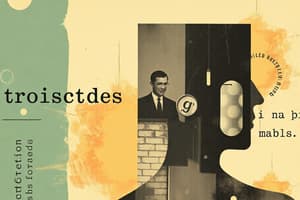Podcast
Questions and Answers
ما هو الفعل الترانزيتيف؟
ما هو الفعل الترانزيتيف؟
- الفعل الذي يأخذ فاعلًا ومفعولًا مباشرًا (correct)
- الفعل الذي يأخذ فاعلًا
- الفعل الذي يأخذ مفعولًا غير مباشر
- الفعل الذي لا يحتاج إلى مفعول
من هو المتلقي في عبارة: 'أعطى لها كتابًا'؟
من هو المتلقي في عبارة: 'أعطى لها كتابًا'؟
- الهيئة
- هي (correct)
- الضمير
- الكتاب
ما المفعول المباشر في الجملة: 'أكلت السندويتش'؟
ما المفعول المباشر في الجملة: 'أكلت السندويتش'؟
- الطبقة
- السندويتش (correct)
- الزمن
- أكلت
ما هو المفعول غير المباشر في الجملة: 'أرسلوا لي رسالة'؟
ما هو المفعول غير المباشر في الجملة: 'أرسلوا لي رسالة'؟
من هو المتلقي في جملة: 'أعطى لها باقة ورود'؟
من هو المتلقي في جملة: 'أعطى لها باقة ورود'؟
من هو المتلقي في عبارة: 'أعطى لصديقه كتابًا'؟
من هو المتلقي في عبارة: 'أعطى لصديقه كتابًا'؟
Flashcards are hidden until you start studying
Study Notes
Verbs and Objects
Verbs are action words that link subjects to objects in sentences. They describe actions performed by a subject or things that happen. In English grammar, verbs can take direct or indirect objects. Direct objects receive the action of the verb, while indirect objects receive something from the direct object. Understanding the relationship between verbs and their objects is essential for crafting clear and effective sentences.
Direct Objects
A direct object typically appears after a transitive verb - a verb that takes a direct object. It tells what the verb acts upon. For example, in the sentence "I saw the tree," "the tree" is the direct object because it shows what the verb acted on. Other examples might include "She ate the sandwich." Here, "the sandwich" is the direct object of the verb "ate." Direct objects often begin with a definite or indefinite article ("the," "a," or "an").
Indirect Objects
The indirect object refers to the person or thing that receives the direct object. In the sentence "He gave her a book," "her" is the indirect object because she received the book, which is the direct object. Another example could be "They sent me a letter," where "me" is the indirect object, and "letter" is the direct object. Indirect objects can also have an article before them, like "mother" in "My mother gave me a toy".
Prepositions
Some prepositions may act as verbs when they come after specific nouns; these constructions are called phrasal verbs. These phrases usually refer to some sort of location or direction. For instance, "send off" means to send away or dismiss someone, while "put off" can mean to delay or cancel an event.
Transitive vs. Intransitive Verbs
Transitive verbs require a direct object to complete their meaning. On the other hand, intransitive verbs do not take a direct object and instead show what the subject is doing, without anything being acted upon. For example, "He kicked the ball" is a sentence with a transitive verb (kicked), as it requires the direct object "ball." In contrast, "She slept soundly" is a sentence with an intransitive verb (slept) because there is no direct object needed to complete its meaning.
Studying That Suits You
Use AI to generate personalized quizzes and flashcards to suit your learning preferences.




